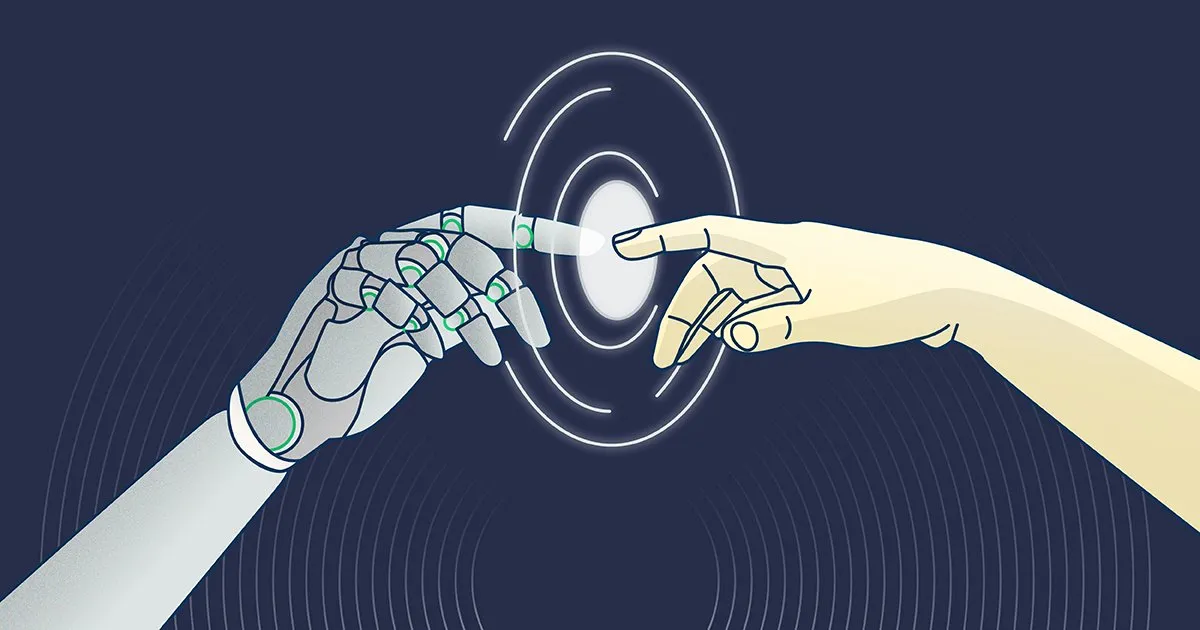In the last couple of months social media platforms have flared up with news about ChatGPT, artificial intelligence (AI), and the potential horrors it could pose in the wrong hands. The truth is, AI is no new friend. It’s been around for years. And no, it is not here to take your job. It could, however, soon become your coworker.
What is ChatGPT?
With all the discussion about AI, it is extremely important to consider how the idea will be introduced to working teams. But first, what exactly is ChatGPT? And what is all the huff about?
It might be best to let ChatGPT introduce itself here. By typing this question into a new chat, it provides this answer:

In layman’s terms, it’s a computer program that is trained on a large amount of data that can understand and respond to human language. Not only can it generate text that is similar to what a human would write or say, but it can be used to perform numerous tasks in a conversational tone and generate rapid responses and tasks, which will automate customer experiences (CX).
This immediately sets off alarm bells for those in customer service positions, because the core functions in their job description often relates to engaging with customers. It is natural to assume that an advanced program could soon replace much of the human component. Simply looking at the evolution of chatbots and how AI has improved it, makes a convincing argument for AI adoption. Keep in mind, though, that the first chatbot was called ELIZA, and was created in 1960. Also, if you have ever used Netflix, Amazon, or any social media platforms, then you’ve unknowingly encountered and engaged with AI in some form. This moment has been 60 years in the making.
Innovations and advancements in the artificial intelligence field are coming in terrifying leaps and bounds, but there is still ample time to take it all in. In a recent interview, Sam Altman, CEO of OpenAI, spoke openly about the slowness with which AI will be introduced when he said: “I think in general we are going to release technology much more slowly than people will like. We are going to sit on it much longer than people will like. Eventually people will be happy with our approach to this, but at the time I realize people want the shiny toy and it is frustrating.”
ChatGPT is not perfect. In fact, Altman himself has called it “deeply imperfect”. It often delivers incorrect information and is, at times, tragically limited in its responses. After testing ChatGPT with some of their more common customer service queries, Mathew Patterson from Help Scout shared his thoughts in a recent article. He writes:
“ChatGPT is not a knowledge base or an encyclopedia. It always sounds confident about its answers, even when they are utterly wrong, and it cannot differentiate between “facts” and made up information. That’s why Stack Overflow temporarily banned the use of ChatGPT-generated answers.”
The way forward
While we believe that AI will not completely replace the human element of the outsourcing industry, it is important to look at the future of AI in BPO, especially with regards to occupations where customer interaction is a daily requirement. However, as HR and CX managers contemplate the possibilities of ChatGPT with a glint in their eyes, they often fail to notice the uneasy stares and hushed conversations within their teams.
- Should I be concerned about my position?
- Am I in danger of being replaced by a machine?
- Is this the end of CX or CS as we know it?
These are some of the questions team members are mulling over when the topic of AI comes up. How can one possibly begin to assuage these concerns, or even dispel them completely?
Introduction: Tech revolutionaries like Musk and Gates have warned us that AI would at some point arrive in the modern workspace. Instead of denying its existence or worth, try to create immediate awareness. Introducing AI to the team might feel like welcoming a new team member, but it is also not dissimilar to onboarding the team to a new CRM platform, though a bit more complex.
Discussion: Open discussions and transparency can guide the process, whether through webinars, training sessions, or effective 1-on-1 meetings. Each team member should have the freedom to voice their views, be it their fears about losing their job, or their concerns about data security.
Training: Proper training on the uses of AI, as well as access to the resources to better understand it, will become a necessity in the workplace. Gone are the days of learning how to use the new office printer. Technology demands that teams stay current and informed about the latest innovations. AI, or CX and CS for that matter, is no different. What is the use of having the latest tech, without having the know-how to apply it properly? If you don’t know where to start, then try to familiarize the team with common AI terms. Check out the list of resources below.
Implementation: Leaders, managers, and fellow team members, can apply a proactive, more pragmatic, approach to the adoption of AI, one that involves the entire team in its implementation. A team-led application of AI will create excitement and stimulate a curiosity about the other benefits of AI. If everyone is invested in the project, then everyone will have a vital role in its success.
These are only some of the next steps to consider as we enter this unknown terrain. While widespread adoption of AI is likely to become the norm, the great differentiator will remain real human interaction. If a valued customer has a real problem, they want a real person to come up with a real solution.

Current use of AI in CX and CS
That said, AI platforms have a lot to offer and can support teams in effective ways. Like all office tools, ChatGPT will go through the rigmarole of updates and improvements in coming months and years, as does all new software or equipment. It is, therefore, important to ensure that everyone in an organization is on the same page.
Showcasing real-world examples of AI in action, can provide an opportunity to better understand the benefits of AI. In its current form, AI is already being used to streamline business operations, to prompt workflows, to automate digital processes, and to scour through massive amounts of data in milliseconds. While this can increase efficiency and productivity, it can also reduce unnecessary or unforeseen costs.
Here are some examples and practical applications of how AI is currently being utilized by CX or CS teams:
- Automation of ticket creation and tagging
- Automation of initial chatbot and email responses
- Conversational AI
- 24-hour self-service
- Data processing
Practical applications of AI for businesses
Boldr‘s e-commerce clients, as well as those who work with sensitive customer information, will find benefit in the fact that AI is being used to automate repetitive tasks, as well as to bolster security systems and processes, which could reduce the occurrence of fraud. Its ability to analyze large amounts of customer data in real-time, enables it to “understand” customer behavior and needs faster than any human being. This will greatly improve and personalize the customer experience journey, not to mention the fact that it can use that data to generate a customer sentiment analysis.
Practical applications of AI in a CX team
The most valuable part of AI, is its ability to make light of the menial tasks that tie up CX teams. Besides streamlining internal functions and processes, AI is invaluable when it comes to repeat inquiries from customers.
Conversational AI is probably the biggest game-changer for customer service. This is the ability for a program to learn how to respond in a more personal or conversational tone, instead of just generating standardized responses based on the parameters of the question. AI programs can be taught to be more personable and give real-time human-sounding responses to customers, which can subsequently be automated.
Where automated AI responses and data processing fail to soothe customer concerns, it will be escalated to a team member, who will have substantial information at hand before making contact with the customer. AI is therefore not a substitute for a functional CX team, but rather a sophisticated digital tool that can refine the team’s capacity to fix problems, as well as their efficiency or their output. With access to AI assistance, each team member can reduce the average handling time of queries or complaints, which will improve their CSAT and KPI reports.
AI RESOURCES
For those who are eager to learn a bit more about how AI can be utilized in a CX team, here are some resources and articles that dig deeper into the many uses of AI in CX and CS:
- 50 AI Terms Every Beginner Should Know
- AI For Everyone – Coursera (Free online course)
- Elements Of AI – University of Helsinki (Free online course)
- The AI CX Summit
- How To Use AI Technology To Improve CX
Every business wants to make a profit and to grow. To do more with what resources it has, not to do the same with less. At this stage, companies should focus on how to leverage AI to do exactly that. They must look for areas where AI can improve the way they run their business, or at least to enhance the experience for their customers. Those who fail to include the use of AI in this part of their business strategy, do so at their own peril.
James Fouche is the Content Manager at Boldr, as well as an author and a columnist. He is passionate about sharing his love of reading and writing with others.


